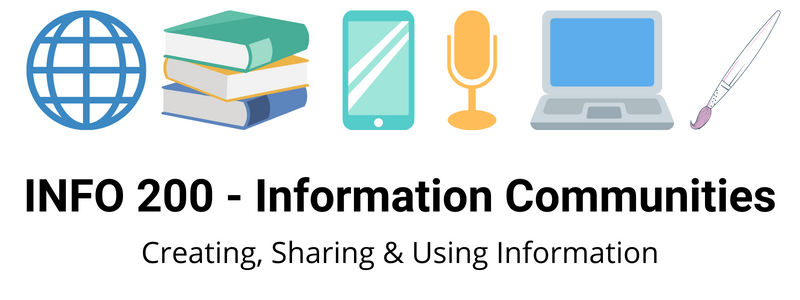Greetings all – I think it would be useful for the next assignments for all of you to work on refining your description of your information community. You wrote a blog post a few weeks ago:
Blog Post #2: Describe the Information Community you are choosing to explore for the course and the research paper. Utilize Durrance and Bishop’s definition and characteristics of Information Communities to describe your choice to the class, as well as other readings and resources described in the lectures.
However, you might want to revisit the description a bit as you go forward. Note the major assignments call for this in their Introductions:
Information Sources Survey: Introduction. Based on your reading in the secondary literature and exploration of your community, describe your chosen information community and the types of information sought and valued by its members.
Literature Review Matrix: Define the Information Community and explain the significance of studying the information behaviors of this group (e.g. why is this research important).
Research Paper: Introduction. Identify the information community being studied and why an examination of this group is significant. This opening section should conclude with an overview of what topics related to the information needs and information-seeking behaviors of the community the paper will address.
A successful description for the assignments addresses who the community is, what information needs and behaviors they have, and should cite some of our foundational literature as well as your own pertinent, peer-reviewed resources. You might even include some stats pulled from research-based sources as well.
Would some of you brave 200 folks like to share the descriptions you have crafted? I think it might inspire others. Did anyone use a good citation for an article that defines community beyond Block and F&F Please share.


Here is what I have so far on my hobby beekeeping community:
Hobby beekeepers have an information seeking behavior that closely aligns with the hobby makers & tinkers of the Serious Leisure Perspective (Stebbins, 2009). Serious leisure has six characteristics: need to persevere, leisure career, serious effort to acquire knowledge and skills, personal benefits, strong identity, and lastly a unique social identity (Hartel, 2010). This form of stewardship relies on hands-on experience/observation from the beekeepers themselves and from other hobby beekeepers within the community. Both, in-person and online beekeeping community sources are helpful in exchanging knowledge. Additionally, Hobby apiarists trust and rely on scientific data to protect their hives against abiotic (pesticides) and biotic (disease) factors (Engelbretson, 2022).
References:
Engebretson, J. M., Nelson, K. C, Steinhauer, N., Rennich, K., Spivak, M., & vanEngelsdorp D. (2022). Perception of honey bee management information sources among backyard and sideliner beekeepers in the united states. Journal of Rural Studies, 96, 190-197. https://doi.org/10.1016/j.jrurstud.2022.10.020
Hartel, J. (2010). Leisure and hobby information and its user. In M. J. Bates (Ed.), Encyclopedia of library and information sciences (3rd ed., pp. 3263–3274). New York, NY: Taylor and Francis.
Stebbins, R.A. (2001). Serious leisure. Society, 38(4), 53–57. https://doi.org/10.1007/s12115-001-1023-8
@sabine Thanks for sharing. You connect to our theories and demonstrate your own research in this paragraph. Have you found stats on beekeepers. I could see another sentence or two detailing something like: “Currently there are an estimated 1 million beekeepers in the US…” or some such.
Thank you for the advice. I will definitely look into that.
@sabine 👍
I have chosen to examine first-generation students. I have found several definitions of this information community.
If you were born in another country and are attending college then according to Wei, Ku and Liao (2011) you are a first-generation college student. If you are the first member of your family to attend college then you are considered a first-generation college student according to the National Center for Educational Statistics (2005). For the purpose of this assignment, I am aligning with Jehangir’s definition of a first-generation college student as “low-income students whose parents have not received a bachelor’s degree.” (Jehangir 2010)
First-generation college students (FGCS) are “more likely than not to be Hispanic or Black”, to come from low-income families, and also to be categorized as a ‘high-risk student.’” (Ishitani, 2003) High-risk students are defined as students who have a greater likelihood of failing or dropping out of college.
References:
Ishitani, T. T. (2003) A longitudinal approach to assessing attrition behavior among first generation students: Time-varying effects of precollege characteristics. Research in Higher Education, 44(4), 433.
Jehangir, R. R., Williams, R., & Jeske, J. (2012). The Influence of Multicultural Learning Communities on the Intrapersonal Development of First-Generation College Students. Journal of College Student Development, 53(2), 267–284. https://doi.org/10.1353/csd.2012.0035
National Center for Education Statistics (NCES). (2005). First-generation students in postsecondary education: A look at their college transcripts 2005. Washington, DC: U.S. Department of Education.
@mkane Thanks for sharing this description. Right on track. Ponder the last bit of the description prompts above – why is it important to study/understand this group?